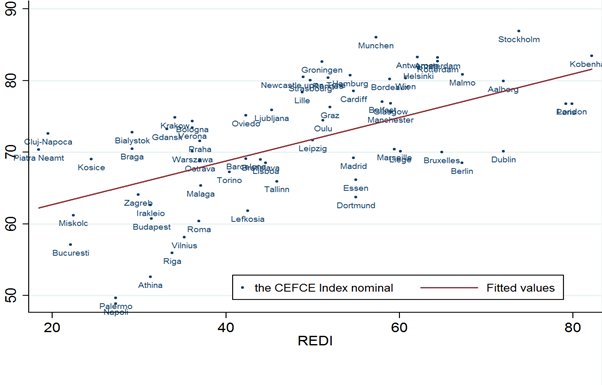– by Héctor O. Pralong, Angel F. Hernaiz, José L. Sebastian –
 Introduction
Introduction
It is a duty of the Government to encourage horizontal links among institutions that are committed towards creating a structural base for the National System of Innovation (SIN) in each discipline. In order to let innovation happen there must be networks and connections between actors. Therefore an agile and proactive State is required. A State that promotes actions that make innovations possible instead of waiting until they occur. One that takes risks, that catalyzes and leads investments, creating working network systems that allow the inclusion of the private sector and the spreading of knowledge to create a Knowledge economy.
The development of the industry of the ICT, pharmacology, nanotechnology, etc. in the last three decades would have hardly occurred without the leading role of the State (Mazzucato, 2011).
According to the Argentine Industrial Union (UIA) it is necessary to go more deeply into the inclusion of SMEs in the system by improving their productivity and it is required to make proactive actions in three fields: the macroeconomic, the transversal sectorial policies and the aid programmes ones.
In the competitive strategy of Argentinian SMEs the more frequently financed actions are trainings, inclusion of technology, innovation promotion, internationalization and business professional management.
Besides, the UIA stated that to have a successful innovation program it is important to maintain a tight link with the enterprises, that the forms and access to the programmes have to be easy and a high diffusion of the programme should be achieved. (UIA in the Seminar “Innovation and SMEs in Latin America”, organized by CEPAL on the 11th June 2015).
The Technology Commission of the Argentinian Confederation for the Medium Enterprise (CAME) proposed to give continuity to the policies supporting productive innovation and product development by facilitating the access to credit and innovation as well as by coordinating national productive interests and innovation policies.
According to CAME and the Central Bank of the Argentine Republic less than 7% of the enterprises accesses public funding. One of CAME´s suggestions was to segment productive credit to address the needs of micro, small and medium size companies. (CAME, circular N° 188/2015, 22nd of May).
Development and conclusions
The goal of this article is to reveal the difficulties of using public instruments that support innovation offered by a public Agency promoting innovation at company level.
Among the projects submitted to the National Agency for Scientific and Technological Promotion (ANPCyT) within the last five years, sixteen proposals have been selected, were approved and reached the execution phase. Selected SMEs had to present a technological innovative project to the Agency including objectives, description of the Project, market potential, budget, human resources with their functions and time dedication, technical goals to be achieved in each development stage to get the technical approval. In addition successful candidates were invited to present the accounting and statute documents required for the legal approval.
The contribution covered up to 70% of the total budget and the project had to be executed in 36 months maximum.
Surveys and personal interviews – using a semi-structured questionnaire – were done.
According to Carlota Pérez, in order to access funding on a medium and long term, SMEs need to meet bank’s requirements that are focused on costs and guarantees. Another alternative is to resort to the stock market, but the entry requirements are usually high (Pérez, García, Jiménez, 2005). This situation is similar to the one presented by Sánchez-Serna and Giraldo-Ávila (2008) that analysed Colombian SMEs. They identified as main difficulty the access to credit – in particular to bank credit – due to the lack or low quality of financial information.
In order to better meet financial needs, public institutions have to consider these difficulties and offer more friendly tools to the productive system enabling SMEs to access financing instruments for their innovative projects.
The success of Argentinian SMEs in innovation programmes fostered by governmental institutions is related to a series of issues, such as simplicity of the procedure at the start, quickness of the evaluation, clarity of the forms and objectives of the programme (Pralong, Sebastián, Hernaiz, 2017). These issues represent a challenge for SMEs, in particular with regard to the access to the programme, that represents a first stage of the innovation process.
According to the data collected, almost the 70% of the consulted companies found that the approval of the submitted project required a long time that put at risk the execution of the proposal because it impacted on the importance or significance of the proposed innovation or due to the loss of value of the budget according to the high inflation of our market.
87% of the consulted companies stated that the execution problems of their projects were not related to the innovation activities carried out but they were connected to external factors, usually of administrative management.
56% of the companies identified difficulties in the execution of the project due to the lack of an advanced payments at the beginning of the project – these advanced payments are not considered by the funding programme. The reimbursement of the money invested by the companies at each stage of execution is delivered once the intermediate technical report is approved and the accomplishment of the goals at each stage is verified.
Some difficulties identified during the project execution are related to the long time between the presentation and evaluation of the receipt and the reimbursement of the amount required. This difficulty was observed by the 56% of the consulted companies.
Nevertheless only one company did not continue with the project while the others managed to conclude it or they are still executing it.
The survey shows that Argentinian SMEs face difficulties in accessing and executing public instruments that promote technological innovation. Thus it would be necessary to adapt these instruments to address SMEs’ needs.
______________________________________________________________
Spanish version
Un estudio sobre la apropiación de instrumentos publicos de innovacion por pymes argentinas
Introducción
Es responsabilidad del gobierno fomentar lazos horizontales entre instituciones tendientes a crear una base estructural para el Sistema Nacional de Innovación (SIN) en cada disciplina, ya que para que la innovación suceda es importante que existan redes y conexiones entre los actores. Por lo que se necesita un estado ágil, proactivo que promueva acciones que posibiliten innovaciones en lugar de esperar a que ocurran, que tome riesgos, que catalice y lidere las inversiones, creando sistemas de redes de trabajo que permitan la incorporación del sector privado y la difusión del conocimiento para crear una economía del conocimiento. En las últimas tres décadas el desarrollo de la industria de las TICs, la farmacéutica, nanotecnología, etc., difícilmente hubiera ocurrido sin el rol de liderazgo del Estado (Mazzucato, 2011).
Para la Unión Industrial Argentina (UIA) es necesario profundizar en la incorporación de la Pymes al sistema mejorando su productividad y para hacerlo es necesario llevar a cabo acciones proactivas dentro de tres ámbitos, el macroeconómico, en políticas sectoriales transversales y programas de apoyo. Dentro de la estrategia competitiva que las Pymes argentinas utilizan con mayor frecuencia se encuentran, la capacitación, la incorporación de tecnología, las actividades de innovación, la inserción internacional y la gestión empresarial profesional. Además, la UIA expresó que para tener un programa de innovación exitoso es importante mantener un vínculo estrecho con las empresas, que los formularios y el acceso al programa sean sencillos y que se alcance una alta difusión del mismo (UIA en el Seminario “Innovación y pymes en América Latina” organizado por CEPAL – 11 DE JUNIO DE 2015).
La Confederación Argentina de la Mediana Empresa (CAME), en su comisión de TECNOLOGÍA propuso dar continuidad a las políticas de apoyo a la innovación productiva y el desarrollo de productos, facilitando el acceso al crédito y a la innovación, así como, alinear los intereses productivos nacionales y las políticas de innovación.
En la mesa de debate de CAME con el Banco Central de la República Argentina se planteó que menos del 7% de las industrias acceden a financiamiento a través de programas públicos. Y una de las sugerencia de CAME fue la de Segmentar el crédito productivo para atender las necesidades de las micro, pequeñas, y medianas empresas (CAME, circular N° 188/2015 del 22 de mayo de 2015).
Desarrollo y conclusiones
El objetivo de este estudio es relevar dificultades de apropiación de instrumentos públicos de innovación propuestos por una Agencia de promoción a la innovación empresarial. Para ello se analizaron 16 casos que pudieron pasar la fase de presentación, de aprobación y alcanzaron la etapa de ejecución. Las empresas Pymes debían presentar un proyecto de innovación tecnológica a la Agencia incluyendo los objetivos, la descripción del proyecto, las potencialidades de mercado, un presupuesto, los recursos humanos con sus funciones y dedicaciones, las metas a alcanzar en cada etapa de desarrollo para la aprobación técnica, así como, la documentación exigida desde el punto de vista contable y estatutario para su aprobación legal. Se podía solicitar un subsidio de hasta un 70% del presupuesto presentado y ejecutarlo en no más de 36 meses. Se realizaron encuestas y entrevistas personalizadas bajo un cuestionario semiestructurado.
Para Carlota Pérez, las necesidades de las Pymes para acceder a financiamiento bancario a mediano y largo plazo se focalizan en cuestiones de condiciones, plazos, costos y garantías exigibles. Otra alternativa es acudir a los mercados de valores, pero los requisitos de entrada suelen ser elevados (Pérez, García, Jiménez, 2005). Situación concordante con la de las Pymes Colombianas que fue presentada por Sánchez-Serna y Giraldo-Ávila (2008) donde postulan como principales dificultades el acceso al crédito, el acceder a financiación bancaria por falta de información financiera o que esta es de baja calidad, las limitadas posibilidades de adquirir recursos propios, problemas para acceder a la financiación que ofrecen los mercados de valores y dificultades para conseguir fondos de inversión.
Por estas razones, los instrumentos públicos deben abordar estas dificultades y ofrecer al sistema productivo herramientas más amigables que permitan el acceso a financiamiento para actividades de innovación por parte de las Pymes
El éxito de las Pymes en la apropiación de los programas de innovación presentados por organismos gubernamentales radica en una serie de cuestiones, como ser, en la simplicidad de los trámites de inicio del proceso, de la rápida evaluación, en la claridad de los formularios y de los objetivos del programa (Pralong, Sebastian, Hernaiz, 2017). Estas cuestiones se visualizan desde las Pymes como dificultades de acceso al programa, que representa una primera etapa del proceso innovador. También se observan dificultades en la ejecución misma de los instrumentos cuando se han superado las barreras de entrada.
Dentro de los resultados encontrados se observa que casi el 70 por ciento de las empresas consultadas sostuvieron que los largos plazos asociados con la aprobación del proyecto presentado para solicitar el financiamiento puso en riesgo la ejecución del mismo porque pusieron en peligro la importancia o relevancia de la innovación propuesta en el proyecto o por el peligro de pérdida de vigencia del presupuesto presentado dada la alta inflación de nuestro mercado.
El 87% de las empresas consultadas sostuvieron que existieron problemas de ejecución de sus proyectos que no se relacionan con las actividades de innovación realizadas sino que se podían asignar a factores externos a la empresa y de índole de gestión administrativa.
El 56% de las empresas consultadas planteó dificultades de ejecución vinculadas a la falta de adelantos para el comienzo del proyecto, ya que el Programa de Financiamiento no los prevé. Las devoluciones de lo invertido por las empresas se realiza una vez aprobadas las rendiciones técnicas intermedias y verificado el cumplimiento de las metas preestablecidas.
Durante la ejecución también se presentaron dificultades con los largos plazos de cada etapa de evaluación y revisión de la Agencia para liberar los reintegros correspondientes y poder proseguir con el desarrollo del proyecto. Esta dificultad se observó en el 56 % de los casos.
De todas maneras solamente una empresa no prosiguió con el proyecto y las demás lo lograron terminar o se encuentran en etapa de ejecución.
Los resultados encontrados dan fuertes indicios sobre que las Pymes argentinas presentan dificultades para acceder y ejecutar instrumentos públicos que promueven la innovación tecnológica empresarial. Por lo que sería necesario adaptar estos instrumentos a las necesidades de las Pymes
Bibliography/Bibliografía
CAME, circular N° 188/2015 del 22 de mayo de 2015.
Encuesta Nacional de Empleo e Innovación (2017). https://www.argentina.gob.ar/noticias/ii-encuesta-nacional-de-empleo-e-innovacion
Mazzucato, M. (2011). Demos. Magdalen House, (2013) Anthem, UK
Pralong, H. O., Sebastian, J. L., y Hernaiz, A. F. (2017). Innovation Vouchers: an application proposal – Bonos de Innovación: una propuesta de aplicación. En, Codner, D. y Garrido, C. “Consolidando acciones cooperativas para la relación de las Universidades con el mundo productivo en el espacio ALCUE” (pp. 182-192). Colección idea latinoamericana digital. Ciudad de México, México: Red Universidad-Empresa ALCUE – UDUAL.
Pérez-López, Carmen; García-Villanueva, Rocío & Jiménez-Naharro, Félix (2005, octubre). La valoración de pequeñas y medianas empresas. Revista Técnica Contable (679), 12-24.
Sánchez-Serna, A.; Giraldo-Ávila, N. (2008). Las necesidades de las pyme –pequeñas y medianas empresas– y el sistema de información contable y financiero como una estrategia para atenderlas. Contabilidad 25.indb vol. 9 / no. 25. Bogotá, Colombia, 5 (25):421-464 / julio-diciembre 2008
UIA en el Seminario “Innovación y pymes en América Latina” organizado por CEPAL – 11 DE JUNIO DE 2015.
Héctor O. Pralong
 Teacher and researcher, Universidad Nacional de Quilmes, UNQ, and Faculty of Psychology – Universidad de Buenos Aires, UBA, Buenos Aires, Argentina. Chemical Engineer, Universidad de Buenos Aires – UBA; Diploma in Specialized Services to support Innovation, Instituto Tecnológico de Estudios Superiores de Monterrey (México); Consultant of the Ministry of Science, Technology and Productive Innovation of Argentina. Vice Director on the Argentine side of the Argentine Brasilian Centre of Biotechnology.
Teacher and researcher, Universidad Nacional de Quilmes, UNQ, and Faculty of Psychology – Universidad de Buenos Aires, UBA, Buenos Aires, Argentina. Chemical Engineer, Universidad de Buenos Aires – UBA; Diploma in Specialized Services to support Innovation, Instituto Tecnológico de Estudios Superiores de Monterrey (México); Consultant of the Ministry of Science, Technology and Productive Innovation of Argentina. Vice Director on the Argentine side of the Argentine Brasilian Centre of Biotechnology.
Angel F. Hernaiz
 Teacher, Universidad Nacional de La Matanza – UNLAM. San Justo, Argentina. Graduate in Physics, UBA. Member of the Area of International Cooperation with Enterprises – Ministry of Science, Technology and Productive Innovation of Argentina.
Teacher, Universidad Nacional de La Matanza – UNLAM. San Justo, Argentina. Graduate in Physics, UBA. Member of the Area of International Cooperation with Enterprises – Ministry of Science, Technology and Productive Innovation of Argentina.
José L. Sebastian
Teacher and researcher, Universidad Nacional de Quilmes, UNQ.
Graduate in Hotels´ Management, Universidad Nacional de Quilmes – UNQ. Director of Observatory of Organizational Management – UNQ.
*The article has been received on the 30th of December 2017.








 The China IPR SME Helpdesk supports small and medium sized enterprises (SMEs) from European Union (EU) member states to protect and enforce their Intellectual Property Rights (IPR) in or relating to China, Hong Kong, Macao and Taiwan, through the provision of free information and services. The Helpdesk provides jargon-free, first-line, confidential advice on intellectual property and related issues, along with training events, materials and online resources. Individual SMEs and SME intermediaries can submit their IPR queries via email (question@china-iprhelpdesk.eu) and gain access to a panel of experts, in order to receive free and confidential first-line advice within 3 working days.
The China IPR SME Helpdesk supports small and medium sized enterprises (SMEs) from European Union (EU) member states to protect and enforce their Intellectual Property Rights (IPR) in or relating to China, Hong Kong, Macao and Taiwan, through the provision of free information and services. The Helpdesk provides jargon-free, first-line, confidential advice on intellectual property and related issues, along with training events, materials and online resources. Individual SMEs and SME intermediaries can submit their IPR queries via email (question@china-iprhelpdesk.eu) and gain access to a panel of experts, in order to receive free and confidential first-line advice within 3 working days. Innovation per se doesn’t automatically translate into economic benefits. To profit from innovation firms need to convert it into viable products or services while also having the capacity to protect the innovation against imitators. This is the appropriability problem I’ll try to address in what follows.
Innovation per se doesn’t automatically translate into economic benefits. To profit from innovation firms need to convert it into viable products or services while also having the capacity to protect the innovation against imitators. This is the appropriability problem I’ll try to address in what follows. Giovanni Zazzerini is the Secretary General of INSME – the International Network for Small and Medium Enterprises. He is also adjunct professor at the Department of Management of LUISS Guido Carli of Rome and contracted professor of Marketing at the Department of Economics of the University of Perugia. He works as an expert for the Italian Ministry of Foreign Affairs in development cooperation projects in China and Vietnam and he is regularly appointed by the European Commission to advise research projects on exploitation of research results, commercialization of innovation and business plan development. Giovanni also worked as a consultant in developing projects in the field of innovation, entrepreneurship and internationalization for SMEs for more than 15 years. Beside public institutions he has advised national and multinational companies (Vodafone, Sky, Ericsson, DHL, etc.). He holds a Ph.D. in Marketing from University of Perugia (Italy), a Master’s Degree in Technology and Innovation Management from SPRU, University of Sussex (United Kingdom) and a Bachelor Degree in Economics from University of Perugia.
Giovanni Zazzerini is the Secretary General of INSME – the International Network for Small and Medium Enterprises. He is also adjunct professor at the Department of Management of LUISS Guido Carli of Rome and contracted professor of Marketing at the Department of Economics of the University of Perugia. He works as an expert for the Italian Ministry of Foreign Affairs in development cooperation projects in China and Vietnam and he is regularly appointed by the European Commission to advise research projects on exploitation of research results, commercialization of innovation and business plan development. Giovanni also worked as a consultant in developing projects in the field of innovation, entrepreneurship and internationalization for SMEs for more than 15 years. Beside public institutions he has advised national and multinational companies (Vodafone, Sky, Ericsson, DHL, etc.). He holds a Ph.D. in Marketing from University of Perugia (Italy), a Master’s Degree in Technology and Innovation Management from SPRU, University of Sussex (United Kingdom) and a Bachelor Degree in Economics from University of Perugia. It is often lamented that small and mid-sized companies show greater deficits in the implemention of Industry 4.0 compared to big companies. We wanted to know if this impression is correct or not: we examined the relationship between different firm-specific factors and the degree to which small and medium-sized enterprises digitized their business processes in the manufacturing sector in the three German federal states North Rhine-Westphalia, Bavaria, and Baden-Wuerttemberg. We measured the degree of digital interconnection between the business units as well to external partners and the use of smart products because we understand Industry 4.0 as the digital interconnection of all entities which are involved in the value-added process. However beside this objective measurement we also asked the companies to assess their potential for digitization.
It is often lamented that small and mid-sized companies show greater deficits in the implemention of Industry 4.0 compared to big companies. We wanted to know if this impression is correct or not: we examined the relationship between different firm-specific factors and the degree to which small and medium-sized enterprises digitized their business processes in the manufacturing sector in the three German federal states North Rhine-Westphalia, Bavaria, and Baden-Wuerttemberg. We measured the degree of digital interconnection between the business units as well to external partners and the use of smart products because we understand Industry 4.0 as the digital interconnection of all entities which are involved in the value-added process. However beside this objective measurement we also asked the companies to assess their potential for digitization.


 The South-East Asia IPR SME Helpdesk supports small and medium sized enterprises (SMEs) from European Union (EU) member states to protect and enforce their Intellectual Property Rights (IPR) in or relating to South-East Asian countries, through the provision of free information and services. The Helpdesk provides jargon-free, first-line, confidential advice on intellectual property and related issues, along with training events, materials and online resources. Individual SMEs and SME intermediaries can submit their IPR queries via email (question@southeastasia-iprhelpdesk.eu) and gain access to a panel of experts, in order to receive free and confidential first-line advice within 3 working days.
The South-East Asia IPR SME Helpdesk supports small and medium sized enterprises (SMEs) from European Union (EU) member states to protect and enforce their Intellectual Property Rights (IPR) in or relating to South-East Asian countries, through the provision of free information and services. The Helpdesk provides jargon-free, first-line, confidential advice on intellectual property and related issues, along with training events, materials and online resources. Individual SMEs and SME intermediaries can submit their IPR queries via email (question@southeastasia-iprhelpdesk.eu) and gain access to a panel of experts, in order to receive free and confidential first-line advice within 3 working days.
 Edita Bagdonaite,
Edita Bagdonaite, Introduction
Introduction Teacher and researcher, Universidad Nacional de Quilmes, UNQ, and Faculty of Psychology – Universidad de Buenos Aires, UBA, Buenos Aires, Argentina. Chemical Engineer, Universidad de Buenos Aires – UBA; Diploma in Specialized Services to support Innovation, Instituto Tecnológico de Estudios Superiores de Monterrey (México); Consultant of the Ministry of Science, Technology and Productive Innovation of Argentina. Vice Director on the Argentine side of the Argentine Brasilian Centre of Biotechnology.
Teacher and researcher, Universidad Nacional de Quilmes, UNQ, and Faculty of Psychology – Universidad de Buenos Aires, UBA, Buenos Aires, Argentina. Chemical Engineer, Universidad de Buenos Aires – UBA; Diploma in Specialized Services to support Innovation, Instituto Tecnológico de Estudios Superiores de Monterrey (México); Consultant of the Ministry of Science, Technology and Productive Innovation of Argentina. Vice Director on the Argentine side of the Argentine Brasilian Centre of Biotechnology. Teacher, Universidad Nacional de La Matanza – UNLAM. San Justo, Argentina. Graduate in Physics, UBA. Member of the Area of International Cooperation with Enterprises – Ministry of Science, Technology and Productive Innovation of Argentina.
Teacher, Universidad Nacional de La Matanza – UNLAM. San Justo, Argentina. Graduate in Physics, UBA. Member of the Area of International Cooperation with Enterprises – Ministry of Science, Technology and Productive Innovation of Argentina.


 Ines Haberl is working for the Austrian Research Promotion Agency (FFG) as National Contact Point (NCP) for SMEs since 2006 and as coordinator of the EU-project “Fit for Health 2.0”
Ines Haberl is working for the Austrian Research Promotion Agency (FFG) as National Contact Point (NCP) for SMEs since 2006 and as coordinator of the EU-project “Fit for Health 2.0” 